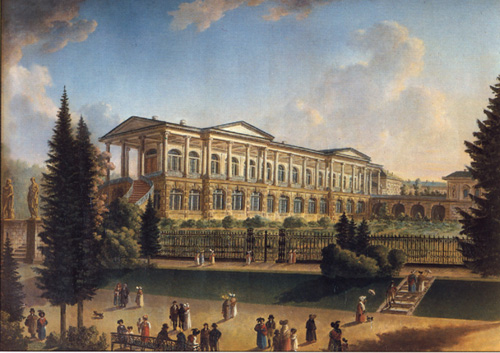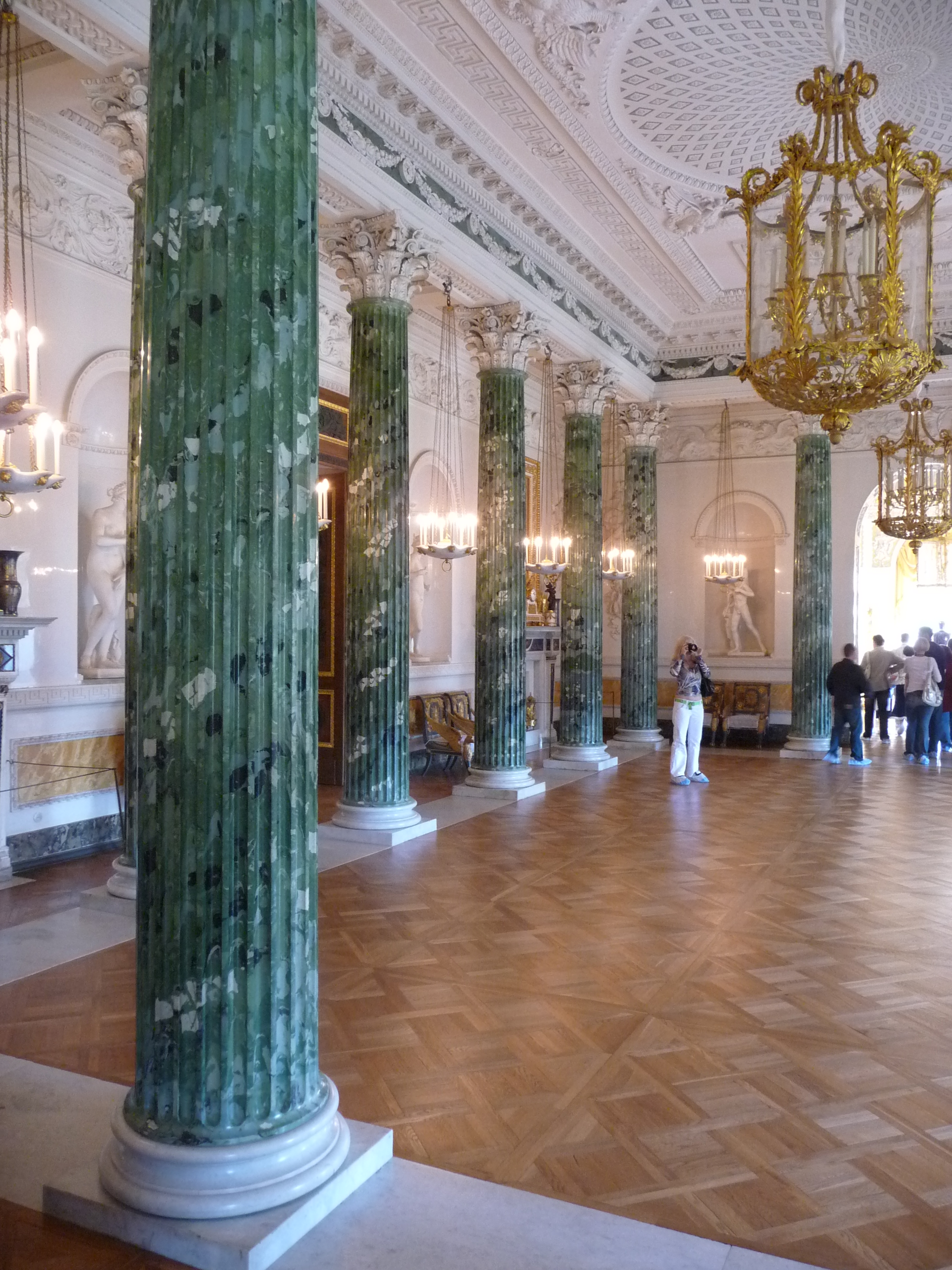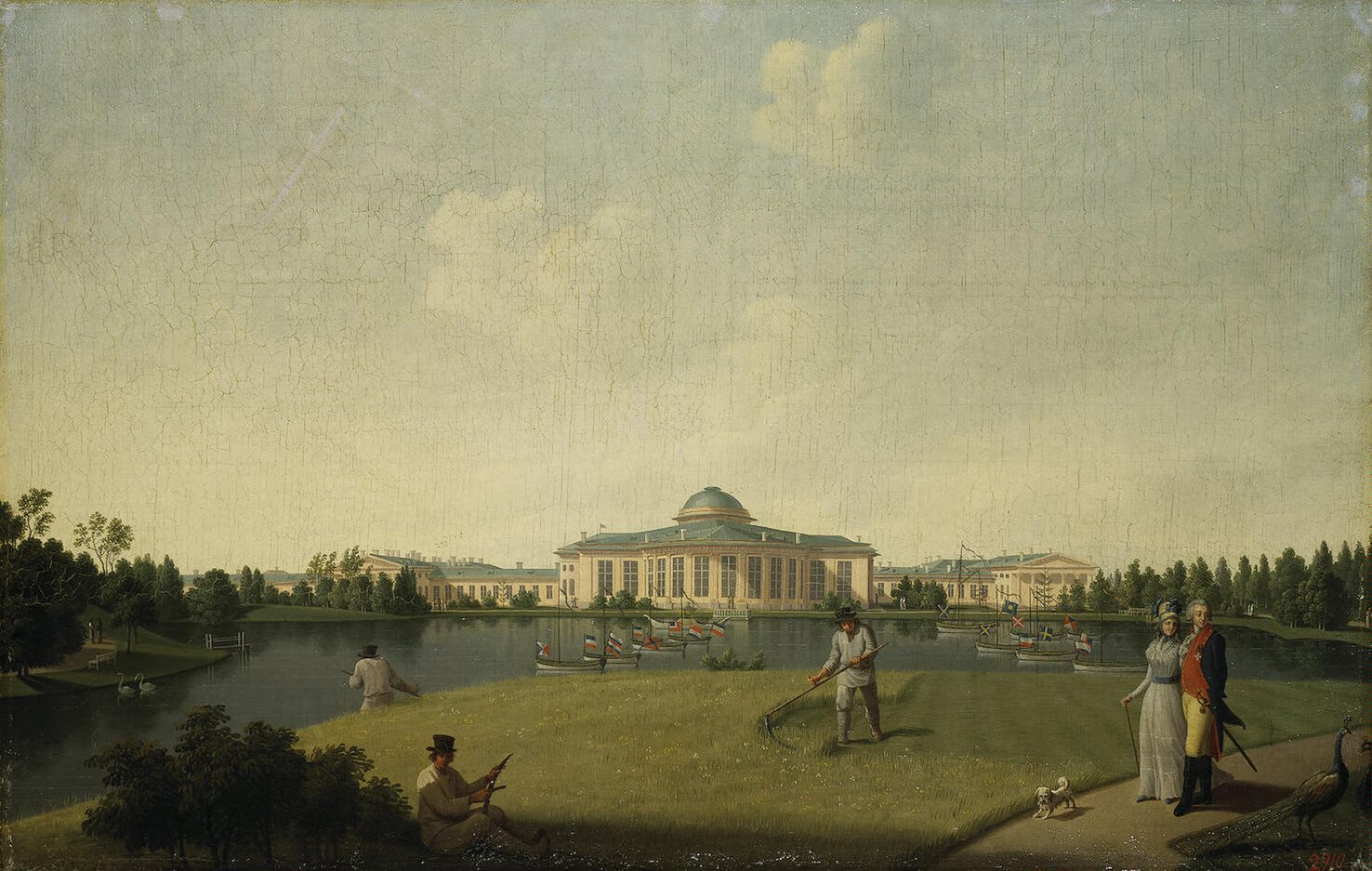Neoclassical architecture in Russia on:
[Wikipedia]
[Google]
[Amazon]
Neoclassical architecture in Russia developed in the second half of the 18th century, especially after Catherine the Great succeeded to the throne on June 28, 1762, becoming Empress of Russia. 





Neoclassical architecture
Neoclassical architecture is an architectural style produced by the Neoclassical movement that began in the mid-18th century in Italy and France. It became one of the most prominent architectural styles in the Western world. The prevailing sty ...
developed in many Russian cities, first of all St. Petersburg, which was undergoing its transformation into a modern capital throughout the reign of Catherine II.






Origin of the style
Background
As part of the European cosmopolitan class of the 18th century, Catherine set the tone of Russian social and intellectual life during her long reign. The Catherinian Era was a turning point in terms of the education ofnobility
Nobility is a social class found in many societies that have an aristocracy (class), aristocracy. It is normally ranked immediately below Royal family, royalty. Nobility has often been an Estates of the realm, estate of the realm with many e ...
, particularly in the fields of art and literature. French became the court language, and along with the language came the ideas of Enlightenment
Enlightenment or enlighten may refer to:
Age of Enlightenment
* Age of Enlightenment, period in Western intellectual history from the late 17th to late 18th century, centered in France but also encompassing (alphabetically by country or culture): ...
as well. Her embrace of the neo-classicism current linked her capital to ancient Rome, and this phenomenon was particularly encouraged by poetic allusions to St. Petersburg as similar to the ancient city, and the empress as the goddess Minerva
Minerva (; ett, Menrva) is the Roman goddess of wisdom, justice, law, victory, and the sponsor of arts, trade, and strategy. Minerva is not a patron of violence such as Mars, but of strategic war. From the second century BC onward, the R ...
. These Roman references must have galvanized her ideas, finally declaring in a letter to Frau Johanna Dorothea Bielcke (1770):'' Augustus said that he found Rome built of brick and would leave it built of marble; I say that I found Petersburg virtually wooden and will leave its buildings dressed in marble.Scholars recognize that, regardless of the motivation, Catherine found in architecture an embodiment for her aspirations, particularly the so-called
Greek Project
The Greek Plan or Greek Project () was an early solution to the Eastern Question which was advanced by Catherine the Great in the early 1780s. It envisaged the partition of the Ottoman Empire between the Russian and Habsburg Empires followed ...
, which aimed to take Istanbul
Istanbul ( , ; tr, İstanbul ), formerly known as Constantinople ( grc-gre, Κωνσταντινούπολις; la, Constantinopolis), is the List of largest cities and towns in Turkey, largest city in Turkey, serving as the country's economic, ...
to recreate a new "Christian Byzantium". According to William Brumfield, the neoclassical revival in Russian architecture was an "expression of nostalgia for bygone cultural values, and a reformulated sense of imperial monumentality."
The beginnings
In 1762, the Empress had ordered the construction of the palace of Oranienbaum, and on that occasion Antonio Rinaldi had built the Chinese Palace (1762–1768) (which presented a mixture of elements ofBaroque architecture
Baroque architecture is a highly decorative and theatrical style which appeared in Italy in the early 17th century and gradually spread across Europe. It was originally introduced by the Catholic Church, particularly by the Jesuits, as a means t ...
, of classicism and of traditional Chinese architecture), and the pavilion Katalnaya Gorka (or " rollercoaster") (1762–1774). In this cylindrical pavilion, which had 3 branching wings, a dome
A dome () is an architectural element similar to the hollow upper half of a sphere. There is significant overlap with the term cupola, which may also refer to a dome or a structure on top of a dome. The precise definition of a dome has been a ...
and a triumphal arch
A triumphal arch is a free-standing monumental structure in the shape of an archway with one or more arched passageways, often designed to span a road. In its simplest form a triumphal arch consists of two massive piers connected by an arch, crow ...
with a tower ending in a spire
A spire is a tall, slender, pointed structure on top of a roof of a building or tower, especially at the summit of church steeples. A spire may have a square, circular, or polygonal plan, with a roughly conical or pyramidal shape. Spires are ...
, the search for new compositional schemes can be observed. In 1763 Catherine commissioned the French architect Jean-Baptiste Vallin de la Mothe and the Russian Alexander Kokorinov for the construction of the new headquarters of the Academy of Fine Arts in St. Petersburg. In 1766, De La Mothe became the official court architect.
From 1764, the Academy was directed by the philanthropist and councilor for education of Catherine Ivan Betskoy. In those years, the empress and Betskoy, who had been a regular patron of a public education system in Russia, had conceived the ambitious project to build an orphanage
An orphanage is a residential institution, total institution or group home, devoted to the care of orphans and children who, for various reasons, cannot be cared for by their biological families. The parents may be deceased, absent, or abu ...
in Moscow
Moscow ( , US chiefly ; rus, links=no, Москва, r=Moskva, p=mɐskˈva, a=Москва.ogg) is the capital and largest city of Russia. The city stands on the Moskva River in Central Russia, with a population estimated at 13.0 million ...
. This idealistic experiment, inspired by the Enlightenment movement, was aimed at creating the "ideal citizen" through the recovery of thousands of orphans who were to receive an adequate education. The project of the orphanage
An orphanage is a residential institution, total institution or group home, devoted to the care of orphans and children who, for various reasons, cannot be cared for by their biological families. The parents may be deceased, absent, or abu ...
was given to Karl Blank who, trained at the school of Bartolomeo Rastrelli, was the architect who had built the first neoclassical buildings in Moscow, including said orphanage.
The 1770s: new impulses
In 1773, the Empress wrote a letter to the Academy of France, announcing a contest which asked the architects to design a house in which they were present, at the same time, forms of both Greek and Roman antiquities. Two French academics, Charles de Wailly andCharles-Louis Clérisseau Charles-Louis Clérisseau (28 August 1721 – 9 January 1820) was a French architect, draughtsman, antiquary, and artist who became a leading authority on ancient Roman architecture and Roman ruins in Italy and France. With his influence extending t ...
, sent their drawings, but these were not welcomed positively. Hence, in 1778, Catherine said she wanted to hire two Italian architects, since "the Frenchmen we have here know too much and build dreadful houses – because they know too much." In 1779, she commissioned her ministers, Baron Friedrich Melchior and Johann Friedrich Reiffenstein, who at that time were representatives of the Russian Academy of Arts
Russian Academy of Arts (RAKh / rus. РАХ, Росси́йская акаде́мия худо́жеств) is the State scientific Institution of Russian Federation, eligible heir to the USSR Academy of Arts. RAKh is the public cultural Instit ...
of St. Petersburg in Rome, to find the two architects. The same year, two Italians architects, and Giacomo Quarenghi
Giacomo Quarenghi (; rus, Джа́комо Кваре́нги, Džákomo Kvaréngi, ˈdʐakəmə kvɐˈrʲenʲɡʲɪ; 20 or 21 September 1744) was an Italian architect who was the foremost and most prolific practitioner of neoclassical architectu ...
, arrived at the court of Catherine. Within a few years, neoclassicism in Russia, which in its first phase had drawn ideas from the French architecture of the mid-eighteenth century, turned its attention to the interpretive experiences of the Palladian architecture, especially of England and Italy.
The 1780s: Giacomo Quarenghi
At the invitation of Catherine's agents in 1779, Giacomo Quarenghi arrived in St. Petersburg along with the Scottish architect Charles Cameron. He was a renowned neoclassical architect, having studied in Rome withAnton Raphael Mengs
Anton Raphael Mengs (22 March 1728 – 29 June 1779) was a German painter, active in Dresden, Rome, and Madrid, who while painting in the Rococo period of the mid-18th century became one of the precursors to Neoclassical painting, which replac ...
, among other artists and architects who helped shape his interest and expertise in Palladian architecture. Together with Cameron, he first worked on the Catherine Palace located in the Tsarskoye Selo
Tsarskoye Selo ( rus, Ца́рское Село́, p=ˈtsarskəɪ sʲɪˈlo, a=Ru_Tsarskoye_Selo.ogg, "Tsar's Village") was the town containing a former residence of the Russian imperial family and visiting nobility, located south from the c ...
. Specifically, this entailed the construction of a two-story gallery (''Cameron's Gallery''). Between 1781 and 1796, it was the turn of the palace
A palace is a grand residence, especially a royal residence, or the home of a head of state or some other high-ranking dignitary, such as a bishop or archbishop. The word is derived from the Latin name palātium, for Palatine Hill in Rome which ...
of Paul I in Pavlovsk which, in its original version, became one of the first examples of Palladian villa built in Russia.
But if Cameron had been successful for the display of his fanciful polychrome, the heirs of Catherine Paul and Maria Feodorovna forced him to absolute sobriety, so at Pavlovsk became prominent the use of white and gold. However, Cameron could not comply to the impositions of the new taste. Between 1786 and 1789 Cameron's duties in Pavlovsk passed to the Italian Vincenzo Brenna
Vincenzo Brenna (1747Lanceray, p. 37, states birth year as 1745. Contemporary historians ( Dmitry Shvidkovsky) agree on 1747 (Shvidkovsky, p. 293) – May 17, 1820) was an Italian architect and painter who was the house architect of Paul I of Russ ...
, hired by Paul in 1782.
In the meantime Quarenghi became the official architect of Catherine II, and between the 1780 and 1785 transformed St. Petersburg into a classical city.
As first assignment, in 1779 Catherine commissioned architect of Bergamo
Bergamo (; lmo, Bèrghem ; from the proto- Germanic elements *''berg +*heim'', the "mountain home") is a city in the alpine Lombardy region of northern Italy, approximately northeast of Milan, and about from Switzerland, the alpine lakes C ...
the task of introducing the neoclassical style in the Peterhof Palace
The Peterhof Palace ( rus, Петерго́ф, Petergóf, p=pʲɪtʲɪrˈɡof,) (an emulation of early modern Dutch "Pieterhof", meaning "Pieter's Court"), is a series of palaces and gardens located in Petergof, Saint Petersburg, Russia, com ...
. The intervention was performed in the southwest of the '' Top Park '', where he was made the '' English Park '' and in its interior the ''English Palace '', which became the model to which inspire in Russia up to the beginning of 19th century for the villas in the countryside. Between 1782 and 1785 he built the Hermitage Theatre whose interior is inspired by the Teatro Olimpico of Vicenza and for the decorations and the capitals
Capital may refer to:
Common uses
* Capital city, a municipality of primary status
** List of national capital cities
* Capital letter, an upper-case letter Economics and social sciences
* Capital (economics), the durable produced goods used f ...
by the ruins of the Theatre of Pompey. Later, between 1787 and 1792, in the Winter Palace
The Winter Palace ( rus, Зимний дворец, Zimnij dvorets, p=ˈzʲimnʲɪj dvɐˈrʲɛts) is a palace in Saint Petersburg that served as the official residence of the Emperor of all the Russias, Russian Emperor from 1732 to 1917. The p ...
Quarenghi had designed and built a place that was the exact replica of the ''Raphael's Loggia'' located in the Apostolic Palace
The Apostolic Palace ( la, Palatium Apostolicum; it, Palazzo Apostolico) is the official residence of the pope, the head of the Catholic Church, located in Vatican City. It is also known as the Papal Palace, the Palace of the Vatican and the ...
in Vatican City, here were then inserted the copies of the drawings of the ceilings. Copies of which were commissioned in 1778 by the Empress to von Grimm who, through Reiffenstein, did reproduce in Rome copies of life-sized vault; the encaustic paintings were made by Christoforo Unterperger.
In 1783, Quarenghi designed the Palace of the State Bank on the Griboyedov Canal, given the importance of the building, the author gives the monument a majestic appearance. Different was the architect's attitude in the most sober Academy of Sciences
An academy of sciences is a type of learned society or academy (as special scientific institution) dedicated to sciences that may or may not be state funded. Some state funded academies are tuned into national or royal (in case of the Unit ...
(1783–1789) where the outside, unadorned, is marked by a heavy porch in Ionic order
The Ionic order is one of the three canonic orders of classical architecture, the other two being the Doric and the Corinthian. There are two lesser orders: the Tuscan (a plainer Doric), and the rich variant of Corinthian called the composi ...
and in the inside the elegant proportions and the solemnity of the spaces remind the taste of ancient Rome.
In those years Quarenghi was also busy, after the interventions of the Russian architect Karl Blank and Francesco Camporesi, to complete the Catherine Palace in Moscow (1790–1797).
Quarenghi had built numerous palaces and brought into vogue an original monumental style, of Palladian inspiration, which was a reference for many architects who worked in Russia, among them Ivan Starov that, for the Prince Potemkin
Prince Grigory Aleksandrovich Potemkin-Tauricheski (, also , ;, rus, Князь Григо́рий Алекса́ндрович Потёмкин-Таври́ческий, Knjaz' Grigórij Aleksándrovich Potjómkin-Tavrícheskij, ɡrʲɪˈɡ ...
, created the Tauride Palace
Tauride Palace (russian: Таврический дворец, translit=Tavrichesky dvorets) is one of the largest and most historically important palaces in Saint Petersburg, Russia.
Construction and early use
Prince Grigory Potemkin of Taurid ...
. The building, consisting of a main building and two adjoining wings complemented by side pavilions, in perfect adherence to the Palladian villa type, served as a model for innumerable manors scattered across the Russian Empire
The Russian Empire was an empire and the final period of the List of Russian monarchs, Russian monarchy from 1721 to 1917, ruling across large parts of Eurasia. It succeeded the Tsardom of Russia following the Treaty of Nystad, which ended th ...
.
Nikolay Lvov
Nikolay Aleksandrovich Lvov (May 4, 1753 – December 21, 1803) was a Russian artist of the Age of Enlightenment. Lvov, an amateur of Rurikid lineage, was a polymathBohlman, p. 45. who contributed to geology, history, graphic arts and poetry, bu ...
's architecture represented the second, "strict" generation of neoclassicism stylistically close to Giacomo Quarenghi
Giacomo Quarenghi (; rus, Джа́комо Кваре́нги, Džákomo Kvaréngi, ˈdʐakəmə kvɐˈrʲenʲɡʲɪ; 20 or 21 September 1744) was an Italian architect who was the foremost and most prolific practitioner of neoclassical architectu ...
. The polymath
A polymath ( el, πολυμαθής, , "having learned much"; la, homo universalis, "universal human") is an individual whose knowledge spans a substantial number of subjects, known to draw on complex bodies of knowledge to solve specific pro ...
architect, among other things, had translated into Russian the treatise '' I quattro libri dell'architettura'' by Palladio
Andrea Palladio ( ; ; 30 November 1508 – 19 August 1580) was an Italian Renaissance architect active in the Venetian Republic. Palladio, influenced by Roman and Greek architecture, primarily Vitruvius, is widely considered to be one of ...
.
The period of Paul I (1796–1801)
Catherine the Great died in 1796, and her son Paul became Emperor; but he had shown signs of mental instability, and it did not last long. His reforms had limited the rights of thenobility
Nobility is a social class found in many societies that have an aristocracy (class), aristocracy. It is normally ranked immediately below Royal family, royalty. Nobility has often been an Estates of the realm, estate of the realm with many e ...
, and in 1801 he was assassinated by a group of conspirators, including his son Crown Prince Alexander. The most significant innovation was the change of taste of which the best example has been reflected in the care of the interior of the Pavlovsk Palace, that the sovereign had chosen as a dwelling. The emperor's wife Maria Feodorovna had tried to introduce into his home the refinements she had known in her visit to France in 1782.M. Praz, p. 228
Bibliography
* Dmitry Shvidkovsky, ''Russian Architecture and the West'', New Haven (Connecticut),Yale University Press
Yale University Press is the university press of Yale University. It was founded in 1908 by George Parmly Day, and became an official department of Yale University in 1961, but it remains financially and operationally autonomous.
, Yale Univer ...
, 2007
* Mario Praz, ''Gusto neoclassico'', Rizzoli, Milano, 1974
*Lionel Kochan
Lionel Edmond Kochan (20 August 1922 – 25 September 2005) was a British historian, journalist and publisher. He is best known for his work in Jewish history, having become an academic historian in his 30s and formerly specialising in European ...
, ''The Making of Modern Russia'', London, 1962
* Howard Colvin, ''A Biographical Dictionary of British Architects, 1600–1840'', 1958; IV edition, Yale University Press, 2008,
* Emil Kaufmann, ''Architecture in the Age of Reason'' – Baroque and Postbaroque in England, Italy, and France, 1955, Harvard University Press
Harvard University Press (HUP) is a publishing house established on January 13, 1913, as a division of Harvard University, and focused on academic publishing. It is a member of the Association of American University Presses. After the reti ...
,
Footnotes
{{DEFAULTSORT:Neoclassical architecture in Russia Architecture in Russia Neoclassical architecture by country